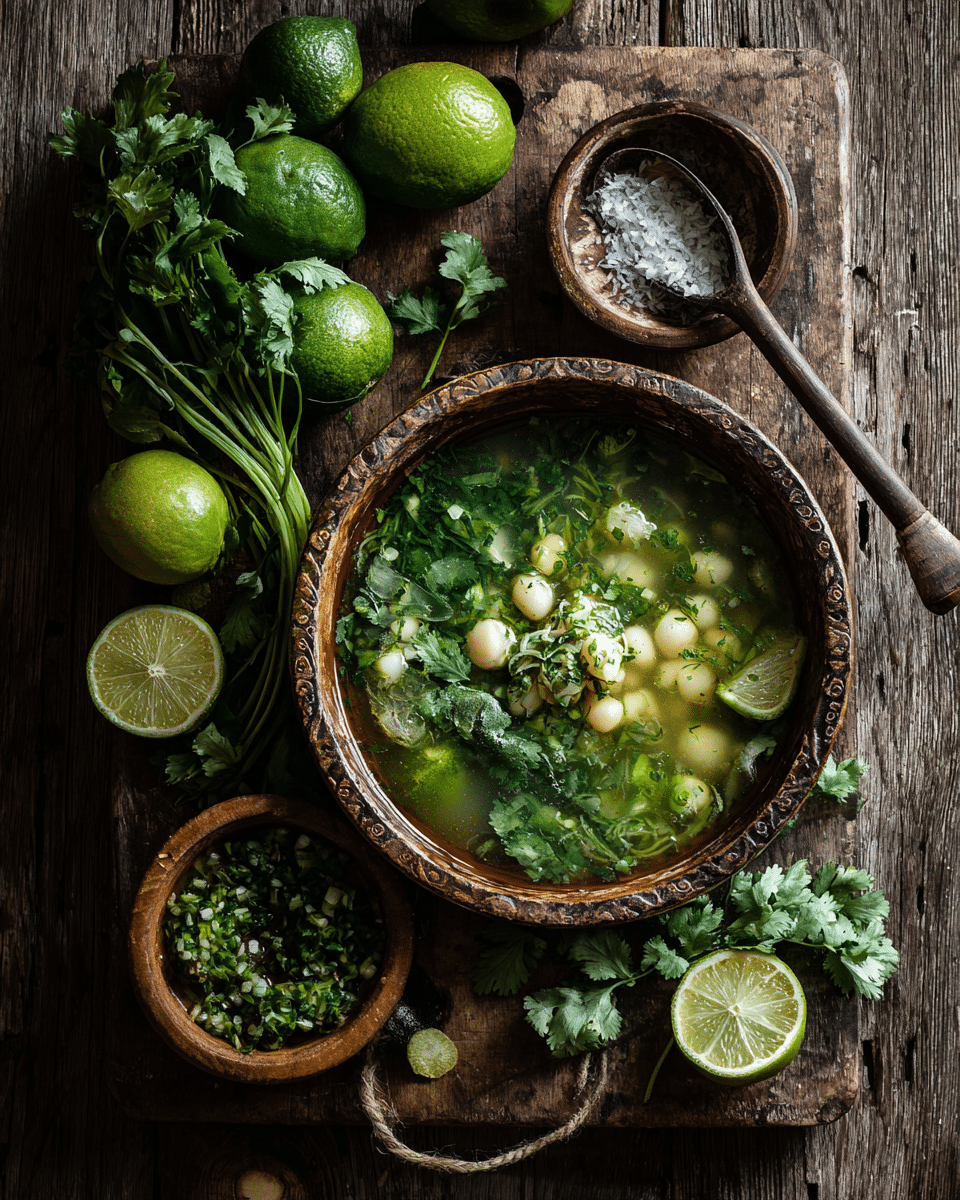Pozole is a traditional Mexican soup steeped in history, often enjoyed during festive occasions such as Mexican Independence Day, Christmas, and family gatherings. This hearty dish features hominy—large, puffy kernels of maize—combined with tender meat and seasoned broth. It comes in different variations, with Pozole Verde using a vibrant green sauce made from tomatillos and green chiles, and Pozole Rojo featuring a rich red sauce made from dried red chiles.
FULL RECIPE
Ingredients
1.For the Soup Base:
- 2 pounds pork shoulder (or chicken for a lighter option), cut into large chunks
- 1 large onion, quartered
- 6 garlic cloves, peeled
- 12 cups water or chicken broth
- 2 bay leaves
- 2 teaspoons salt (plus more to taste)
- 1 teaspoon black pepper
- 2 (30-ounce) cans hominy, drained and rinsed
2.For Pozole Verde Sauce:
- 1 pound tomatillos, husked and rinsed
- 4–5 fresh poblano peppers
- 2–3 fresh jalapeños or serrano chiles (adjust for heat)
- 1 cup fresh cilantro leaves
- 1 cup fresh spinach leaves (optional, for color)
- 1 teaspoon ground cumin
3.For Pozole Rojo Sauce:
- 5 dried guajillo chiles, stemmed and seeded
- 3 dried ancho chiles, stemmed and seeded
- 2 dried pasilla chiles, stemmed and seeded (optional, for depth)
- 1 teaspoon ground cumin
- 1 teaspoon dried oregano
4.For Garnishes:
- Shredded cabbage or lettuce
- Diced onion
- Sliced radishes
- Lime wedges
- Avocado slices
- Chopped cilantro
- Crushed tostadas or tortilla chips
Directions
- Prepare the meat – In a large stockpot, combine pork (or chicken), onion, garlic, bay leaves, salt, and pepper with the water or broth. Bring to a boil, reduce heat, and simmer for about 1.5–2 hours (or until meat is tender), skimming off foam as needed. Remove meat, shred into bite-sized pieces, and set aside. Reserve the cooking liquid as the soup base.
- Make Pozole Verde sauce – For the green version, roast poblano and jalapeño peppers over an open flame or under a broiler until charred. Peel skins, remove seeds, and blend with tomatillos, cilantro, spinach, cumin, and 1 cup of broth until smooth.
- Make Pozole Rojo sauce – For the red version, toast dried chiles in a dry skillet until fragrant. Soak them in hot water for 15 minutes to soften. Blend with cumin, oregano, and 1 cup of broth until smooth. Strain if desired for a silky texture.
- Combine and simmer – Add the sauce of your choice to the soup base, along with hominy and shredded meat. Simmer for 30 minutes, allowing flavors to meld. Adjust seasoning with more salt and pepper if needed.
- Serve – Ladle pozole into bowls and serve hot, accompanied by a generous selection of garnishes so each person can customize their own bowl.
Nutrition Facts
- Calories: 350
- Total Fat: 15g
- Saturated Fat: 5g
- Cholesterol: 65mg
- Sodium: 680mg
- Total Carbohydrates: 28g
- Dietary Fiber: 6g
- Sugars: 4g
- Protein: 25g
Historical and Cultural Importance of Pozole
Pozole is a dish with deep roots in Mexican culture, dating back to pre-Hispanic times. Originally, it was made as a ceremonial meal by the Aztecs and other indigenous groups, using hominy and various meats. Over centuries, it evolved into the beloved festive soup known today, commonly served during major holidays like Mexican Independence Day and Christmas. Pozole’s significance lies not only in its rich flavors but also in its role as a symbol of community and celebration, bringing families together around the table to share a hearty, comforting meal.
Pozole Verde vs. Pozole Rojo: Flavor Profiles and Ingredients
Pozole comes primarily in two popular variations: verde (green) and rojo (red). Pozole Verde is characterized by its bright, fresh flavors derived from tomatillos, poblano peppers, cilantro, and sometimes spinach, giving it a vibrant green color and a slightly tangy, herbaceous taste. In contrast, Pozole Rojo uses dried red chiles like guajillo and ancho, offering a smoky, deep, and mildly spicy flavor with a rich reddish hue. Both versions are equally delicious, with the choice often depending on regional preference and the flavor profile you desire.
Choosing the Right Meat for Pozole
While pork shoulder is the traditional choice for pozole due to its tenderness and fat content that enriches the broth, chicken is a popular lighter alternative. Some variations include beef or even turkey, depending on family or regional traditions. The key is slow simmering the meat until it becomes tender enough to shred easily, allowing it to soak up the broth’s spices. Meat also adds protein and richness, making pozole a well-rounded and filling meal.
Health Benefits and Nutritional Considerations
Pozole is a nutrient-dense dish packed with protein from the meat and fiber from the hominy and fresh vegetables served alongside it. Hominy provides complex carbohydrates and is naturally gluten-free, suitable for many dietary needs. The broth contains vitamins and minerals from the meat, chiles, and herbs. However, traditional pozole can be high in sodium and fat, particularly when using fattier cuts of pork and salt-heavy broth. Modifications such as lean meats, reduced salt, and controlled portions of garnishes can make it a healthier option without sacrificing flavor.
Customizable Garnishes: Adding Freshness and Texture
One of pozole’s most appealing features is its interactive serving style. Guests traditionally add their preferred garnishes to each bowl, tailoring the flavor and texture to their liking. Popular toppings include shredded cabbage or lettuce for crunch, diced onion for sharpness, thinly sliced radishes for peppery freshness, creamy avocado slices, and lime wedges for acidity. Crunchy tortilla chips or tostadas add a satisfying crisp element. This customization makes each serving unique and adds a balance of textures and flavors to the hearty soup.
Regional Variations Across Mexico
While pozole’s basic concept is consistent, regional differences create distinct takes on the dish. In Guerrero, for example, pozole rojo often includes additional spices and thickened sauces. Jalisco’s pozole is famous for its rich pork broth and robust use of garnishes. Meanwhile, the state of Sinaloa favors seafood pozole with shrimp and fish, demonstrating the dish’s versatility. These regional nuances reflect Mexico’s diverse culinary landscape and offer exciting ways to experience pozole beyond the traditional recipes.
Serving Suggestions and Meal Pairings
Pozole is typically served as a main course due to its hearty nature. It pairs wonderfully with warm corn tortillas or fresh flour tortillas to scoop up the broth and toppings. Side dishes like Mexican rice and refried beans can complement the meal, enhancing its comfort food status. For beverages, aguas frescas such as horchata, tamarind, or jamaica (hibiscus) provide a refreshing counterpoint to the soup’s warm spices. In festive settings, pozole is often enjoyed alongside traditional Mexican beers or margaritas.
Advertisement
Storage and Reheating Tips for Pozole
Pozole stores well and often tastes even better the next day as the flavors meld further. Leftovers should be refrigerated promptly in airtight containers for up to 3–4 days. When reheating, use a stovetop to gently warm the soup, stirring occasionally to prevent sticking or scorching. If the broth has thickened too much, add a little water or broth to restore the desired consistency. Pozole can also be frozen for up to three months, though it’s best to freeze the broth and meat separately from the garnishes to maintain texture.
Conclusion
Pozole Verde and Rojo remain iconic dishes in Mexican cuisine, celebrated for their rich history, bold flavors, and communal nature. Whether you prefer the tangy freshness of verde or the smoky depth of rojo, pozole offers a versatile and hearty meal perfect for festive occasions or cozy dinners. Its customizable garnishes and regional adaptations allow endless exploration, inviting cooks of all skill levels to savor and share a piece of Mexican heritage.






